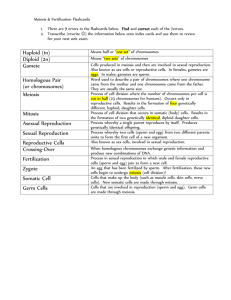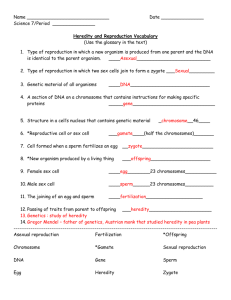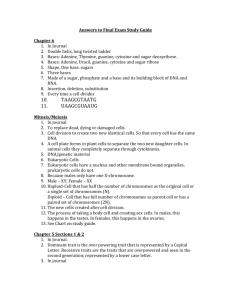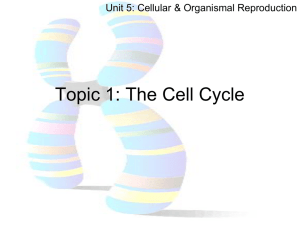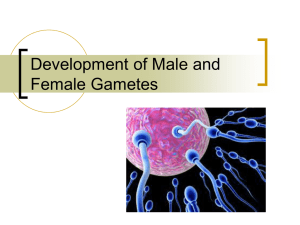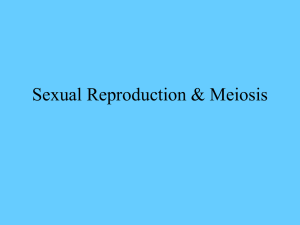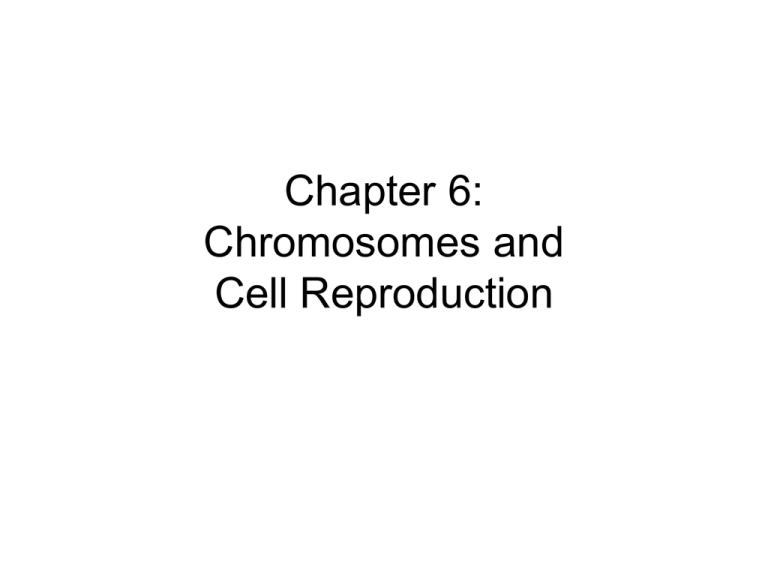
Chapter 6:
Chromosomes and
Cell Reproduction
Section 1: Chromosomes
• How many cells do you think are produced
by the human body everyday?
• 2 trillion cells, that’s 25 million cells every second
• Why do cells divide?
• Cells need to grow, develop and repair themselves
• When a cell divides, the DNA must be
copied before the genetic information is
distributed
Sexual vs. Asexual Reproduction
• Organisms reproduce two different ways:
– Sexual reproduction requires two parents
(one male and one female) to make a
genetically similar offspring.
• Gametes are an organism’s reproductive cells
– Males have sperm
– Females have eggs
– Asexual reproduction requires only one
parent to make a genetically identical
offspring
Prokaryotic Cell Reproduction
• Bacteria have a single circular strand of
DNA that “floats” around the cell; the DNA
is not contained within a nucleus
• Prokaryotes reproduce by a type of cell
division called binary fission.
• Binary fission is a form of asexual
reproduction; a single parent passes exact
copies of all of its DNA to its offspring.
Binary Fission
Eukaryotic Cell Reproduction
• In eukaryotes, DNA is organized into units
called genes
• Genes are small segments of DNA
• A single molecule of DNA has thousands
of genes lined up next to each other
Chromosomes
• When a cell prepares to divide, the DNA
coils up into a structure called a
chromosome.
• Each chromosome has two strands; each
strand is an exact copy of the other.
• Each individual strand is called a
chromatid.
• The two chromatids are connected by a
point called a centromere.
Chromosome Structure
• Homologous
chromosomes are
those that are
identical in structure
• Most humans have 23
pairs of chromosomes
(46 total)
• There are two types
of cells: somatic
(body cells) and
gametes (sex cells)
Chromosome Number
• When egg and sperm fuse
together during fertilization,
a single cell is formed
called a zygote.
• The egg and sperm each
have 23 individual
chromosomes.
• When fertilized, the zygote
has 46 chromosomes
(23+23)
Sex Chromosomes
• In humans and other
organisms, the two sex
chromosomes are referred
to as the X and Y
chromosomes.
• Males are XY and females
are XX.
• Males determine the sex of
new offspring because
females only have an X to
contribute to the zygote.
Mutations
• Mutations are changes in an organism’s
chromosome structure.
• There are four type of mutations. Sketch
each mutation in your notes using page
124 in text.
– deletion
– duplication
– inversion
– translocation
Section 2: The Cell Cycle
• Cell cycle – a repeating sequence of events
that allow a cell to grow and divide.
• How do cells know when to divide?
• Just as traffic lights control the flow of traffic,
cells have a system that controls the phases
of the cell cycle.
• Cells have a number of “red light-green light”
switches that regulate information traveling
through the cell.
• Cells can’t divide
unless they pass
all checkpoints with
green lights.
• Yellow or red lights
would slow or stop
cell division.
Cancer
• Sometimes cells have mutated
chromosomes that lead to cancer. These
cancer cells can change all the
checkpoints to green lights and they coast
through the cell cycle reproducing rapidly.
• All cancers are different, but if scientists
can figure out what changes all the
checkpoints to green lights we could cure
cancer.
Chapter 7: Meiosis
and Sexual Reproduction
Formation of Gametes
• To make sex cells (egg and sperm), many
living things undergo a process called
meiosis.
• Meiosis is a form of cell division that
halves the number of chromosomes.
• Meiosis involves two divisions:
– Meiosis I
– Meiosis II
Reasons for Genetic Variation
Random Fertilization:
• Except for twins, no two people are exactly
alike. This is because there are so many
millions of sperm or eggs within a given
individual that have a chance to be
fertilized.
• About 223 or 8 million different sperm or
egg exist inside of one living individual.
• Because fertilization of an egg by a sperm
is random, the number of possible
outcomes is 64 trillion (8 x 8)
Crossing Over
• Chromosomes have the
ability to cross over during
the early stages of meiosis I.
• Crossing over – when
sections of a chromatid on
one homologous
chromosome are broken or
exchanged with a section of
the other chromatid on the
corresponding chromosome.
Gamete Formation
• Males produce sperm through a process
called spermatogenesis.
• Females produce eggs through a process
called oogenesis.
• After undergoing meiosis I and II, 4 sperm
are produced but only 1 egg survives.

